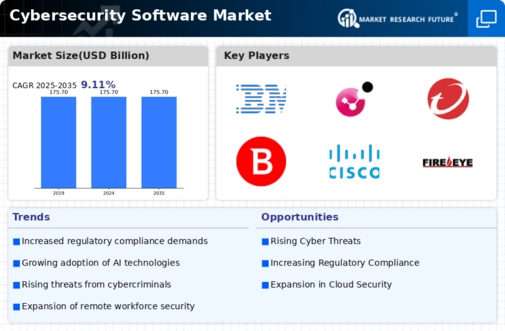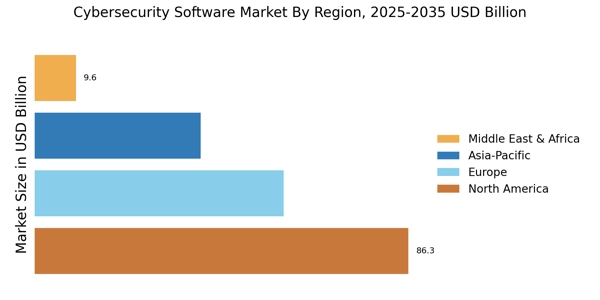Rising Cyber Threats
The increasing frequency and sophistication of cyber threats is a primary driver for the Cybersecurity Software Market. Organizations are facing a myriad of attacks, including ransomware, phishing, and advanced persistent threats. According to recent data, cybercrime is projected to cost businesses over 10 trillion dollars annually by 2025. This alarming trend compels companies to invest in robust cybersecurity solutions to protect sensitive data and maintain operational integrity. As a result, the demand for advanced cybersecurity software is surging, with the market expected to grow significantly in the coming years. The Cybersecurity Software Market is thus witnessing a shift towards more comprehensive and proactive security measures, as organizations seek to mitigate risks associated with these evolving threats.
Adoption of Remote Work Practices
The shift towards remote work practices has emerged as a significant driver for the Cybersecurity Software Market. As organizations adapt to flexible work environments, the attack surface for cyber threats has expanded. Employees accessing corporate networks from various locations and devices create vulnerabilities that cybercriminals are eager to exploit. Consequently, businesses are increasingly investing in cybersecurity software that can secure remote access and protect sensitive information. The market for endpoint security solutions, in particular, is experiencing rapid growth, as organizations seek to safeguard their remote workforce. This trend underscores the necessity for comprehensive cybersecurity strategies, further propelling the Cybersecurity Software Market.
Increased Regulatory Requirements
The Cybersecurity Software Market is significantly influenced by the growing number of regulatory requirements imposed on organizations. Governments and regulatory bodies are enacting stringent laws to protect consumer data and ensure privacy. For instance, regulations such as the General Data Protection Regulation (GDPR) and the California Consumer Privacy Act (CCPA) mandate organizations to implement robust cybersecurity measures. Compliance with these regulations often necessitates the adoption of specialized cybersecurity software, driving market growth. As organizations strive to avoid hefty fines and reputational damage, the demand for compliance-focused cybersecurity solutions is likely to rise. This trend indicates a strong correlation between regulatory pressures and the expansion of the Cybersecurity Software Market.
Growing Awareness of Cybersecurity Risks
There is a notable increase in awareness regarding cybersecurity risks among organizations and consumers alike, which is driving the Cybersecurity Software Market. As high-profile data breaches and cyber incidents make headlines, businesses are becoming more cognizant of the potential repercussions of inadequate cybersecurity measures. This heightened awareness is prompting organizations to prioritize cybersecurity investments, leading to a surge in demand for advanced software solutions. Furthermore, educational initiatives and training programs are being implemented to enhance understanding of cybersecurity best practices. This cultural shift towards valuing cybersecurity is likely to sustain the growth of the Cybersecurity Software Market, as organizations recognize the importance of protecting their digital assets.
Technological Advancements in Cybersecurity
Technological advancements are playing a crucial role in shaping the Cybersecurity Software Market. Innovations such as artificial intelligence, machine learning, and blockchain technology are being integrated into cybersecurity solutions, enhancing their effectiveness against evolving threats. These technologies enable organizations to detect and respond to cyber incidents more swiftly and accurately. The market is witnessing a trend towards automation and real-time threat intelligence, which is essential for staying ahead of cybercriminals. As organizations seek to leverage these advancements to bolster their security posture, the demand for cutting-edge cybersecurity software is expected to rise. This trend indicates a dynamic evolution within the Cybersecurity Software Market, driven by the need for more sophisticated and adaptive security solutions.


















Leave a Comment